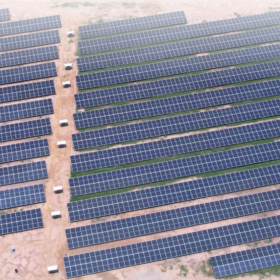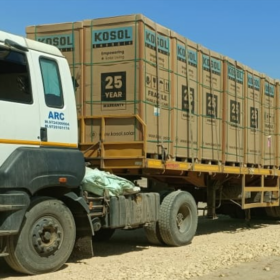It has become increasingly critical to integrate a highly technological-backed infrastructure to generate solar power and meet high energy demands. India drives the energy sector’s growth at a global level on account of being one of the most affordable producers of solar energy worldwide. As renewable energy costs continue to fall, the country recognizes the advantages of installing solar power systems over running coal-fired plants.
One of the primary challenges that renewable energy projects such as solar and wind parks face is the need for land. Private players are generally prohibited from acquiring large tracts of land in rural areas due to the existence of state land-ceiling laws. Hence, there are systematic measures that address these gaps in land allotment for large-scale solar and wind projects towards a more sustainable response to the exponential rise in renewable investments.
Scaling up India’s ambitious climate change agenda, Prime Minister Narendra Modi emphasized how India will increase its non-fossil energy capacity to 500 GW and meet 50% of its energy requirements through renewable energy by 2030. Under his leadership and the various schemes and incentives laid down by the Central government, we are seeing a rapid push towards renewable energy power generation in India.
It would be crucial to point out here that just the solar sector accounts for 60% (280GW) of India’s promised 500GW by 2030. Therefore, 25GW of solar capacity must be installed each year to meet the said target. There are ongoing efforts and policies to install solar rooftops on public buildings, airports, railway networks, educational institutions, residential sectors, and commercial complexes. Nonetheless, the Indian solar sector faces several challenges in developing and managing large-scale solar facilities.
Some of the major challenges faced by solar developers in India during land acquisitions include:
1. Connectivity for evacuating power generated: The bidding process for solar plants favors the company that owns at least half of the land required for the size of the connectivity. This presents two serious challenges: first, securing the land before winning the bid becomes a capital cost for the investor, and second, winning a bid without a land bank becomes an uphill challenge when it comes to land acquisition. The state government does not play a proactive role and usually takes a back seat in these transactions and usually acts as a third party during the process of companies seeking evacuation at state GSS. Our solar policy needs a transparent and uniform push from the center due to the lack of a uniform solar policy across states.
2. Attaining environmental and local clearance from authorities: When it comes to obtaining a land parcel for a solar plant, there are numerous legalities to consider. The land is governed by various issues of environment, wildlife, legal title, ceiling limit, SEBI monitored assets of PACL, government land allotment, state laws on ancestral property sale, khatedari rights, and more. The never-ending conflict between conservationists and land seekers is unavoidable, and this challenge continues to remain to date.
3. Right of way (ROW) for the transmission line: Studying land laws and shortlisting potential sites gives a head start on the solar project. This is followed by a geotechnical survey, revenue road and bypassing land analysis, and a low-tension transmission line. Connecting the switchyard to the State Transmission Utility (STU) and Central Transmission Utility (CTU) is the most difficult ROW challenge. A 20-kilometer power line requires at least 67-70 towers, which requires approvals from various government and private agencies and local body authorities, further creating an even greater challenge for the industry.
4. Overlap of land record: While getting the sale deed registered in the company’s name is one aspect, getting the actual possession of the land parcel is another challenge. Another major issue in land acquisition is figuring out which land belongs to which village.
Different records maintained by adjoining villages lead to an overlap of land records between the villages. Constant redrawing of village boundaries, coupled with non-digitized property paper records, leads to the overlap. Reaching an amicable solution between villages requires a team of all patwaris (including the present one and the past ones) under the command of the district collector to ensure that the land quantum registered is correct and readily available. There are many layers involved, which include dealing with local tehsildar, sub-divisional magistrate, and local patwari who get involved to effectively get the land demarcation process accomplished.
5. Lack of technology or digitalization: One of the significant challenges is the lack of technology or digitalization solution. The multiple records and information are available across various departments including online and offline. Problems like threat to the Great Indian Bustard habitat, colonization, stress on common water resources such as Indira Gandhi Canal Project, forest, environment, PACL, and others must be effectively clubbed into a singular platform for efficiency and speedy land record checks and acquisitions.
The aforementioned factors lead us to the inevitable conclusion that land acquisition continues to be a significant challenge for solar developers in India. While the Central and the State Governments have taken several proactive steps to make it easier for solar developers to acquire land for their projects, land aggregation remains the single biggest roadblock in implementing large-scale projects, resulting in a slowdown in the industry.
Datta Infra is a leading land aggregator and land development player across India, catering to the growing demand of the country’s top renewable corporations. It has successfully delivered and is spearheading some crucial projects ranging from land consolidation to providing transmission and connectivity solutions to players like Tata Power, SunSource Energy and NTPC.
The views and opinions expressed in this article are the author’s own, and do not necessarily reflect those held by pv magazine.
This content is protected by copyright and may not be reused. If you want to cooperate with us and would like to reuse some of our content, please contact: editors@pv-magazine.com.








By submitting this form you agree to pv magazine using your data for the purposes of publishing your comment.
Your personal data will only be disclosed or otherwise transmitted to third parties for the purposes of spam filtering or if this is necessary for technical maintenance of the website. Any other transfer to third parties will not take place unless this is justified on the basis of applicable data protection regulations or if pv magazine is legally obliged to do so.
You may revoke this consent at any time with effect for the future, in which case your personal data will be deleted immediately. Otherwise, your data will be deleted if pv magazine has processed your request or the purpose of data storage is fulfilled.
Further information on data privacy can be found in our Data Protection Policy.